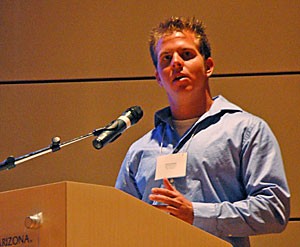The 35th annual Geosciences Symposium was filled with food, faculty, alumni and students – along with their cutting-edge research projects.
Officially named GeoDaze, the three-day event gave undergraduate researchers and graduate students the chance to display their knowledge and discoveries on topics like land formations, earthquakes and climate changes.
“”The symposium is completely student-run, and it is a chance to fill the department in on what the students have been working on all year,”” said Amanda Reynolds, co-chair of the Geosciences Symposium.
The presentations were also judged, and $200-$300 prizes were awarded to first and second place with a grand prize of $1,000, Reynolds said. The symposium was open to students in any department related to earth science. The winners will be announced today, the last day of the symposium.
“”It’s a great way for all the students to present their work professionally,”” said Susan Beck, professor and department head of geosciences.
The symposium also welcomes members of the geosciences industry, and many of the research projects will get published in scientific journals later this year.
“”It (the symposium) makes me feel really proud,”” Beck said. “”I feel proud of the whole department, not just my students.””
Geosciences graduate student Andy Frassetto studies seismology, and his research, which is part of his dissertation, demonstrates why certain mountains in the central and northern Sierra Nevada appear to be getting taller over time.
“”It’s like a ship cutting anchor,”” Frassetto said of the mountains, as they shift away from the “”root”” below the earth’s crust and eventually fall off into the earth’s mantel.
Frassetto would like to study earthquakes and work for the United States Geological Survey after earning his doctorate. He credited his research project in part to George Zandt, a geosciences professor.
Frassetto said he hopes the team completes the project by December but also wants to compare the project to a data set from British Columbia that has a similar setting.
More findings on the topic could be in the next Geoscience Symposium.
“”GeoDaze is great,”” Frassetto said. “”I’ve been here for three years and it gets better every year.””









